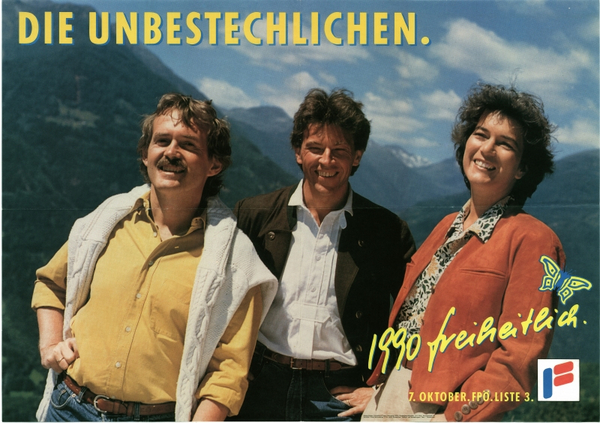
National Council election 1990
At the National Council election of 7 October 1990, the FPÖ nominated Norbert Gugerbauer as its lead candidate. The Freedom Party was able to achieve 16.84 percent of the vote (an increase of 6.91 percentage points) and 33 seats (plus 15).
The party holding the chancellorship, the SPÖ, experienced only modest losses, while the junior government party, the ÖVP, suffered heavy losses of almost 10 percentage points.
Brief description of the election campaign
The regular National Council election of 1990 was the first held after the Freedom Party’s consolidation under Jörg Haider and it constituted the next milestone in the FPÖ’s rise during the 1990s. As Jörg Haider’s first election as Governor of Carinthia had taken place in 1989, the FPÖ put forward Norbert Gugerbauer, an Upper Austrian lawyer, as its lead candidate.
At a time when the Cold War was coming to an end and the communist Eastern Bloc was collapsing, Austria was to some extent also experiencing a mood of upheaval.
That in turn provided fertile soil for the rise under Jörg Haider of the Freedom Party, whose election line was rooted in this desire for change. One central campaign slogan was "Die Kraft der Erneuerung " (“The power of renewal”); another was "1990 freiheitlich" ("1990 freedom"). A poster with Norbert Gugerbauer, Jörg Haider and Heide Schmidt in front of a beautiful alpine backdrop and entitled “Die Unbestechlichen” (“The Untouchables”), became legendary, and was intended as a barb directed against the SPÖ and ÖVP’s system of patronage and cronyism.The regular National Council election of 1990 was the first held after the Freedom Party’s consolidation under Jörg Haider and it constituted the next milestone in the FPÖ’s rise during the 1990s. As Jörg Haider’s first election as Governor of Carinthia had taken place in 1989, the FPÖ put forward Norbert Gugerbauer, an Upper Austrian lawyer, as its lead candidate.
At a time when the Cold War was coming to an end and the communist Eastern Bloc was collapsing, Austria was to some extent also experiencing a mood of upheaval.
That in turn provided fertile soil for the rise under Jörg Haider of the Freedom Party, whose election line was rooted in this desire for change. One central campaign slogan was "Die Kraft der Erneuerung " (“The power of renewal”); another was "1990 freiheitlich" ("1990 freedom"). A poster with Norbert Gugerbauer, Jörg Haider and Heide Schmidt in front of a beautiful alpine backdrop and entitled “Die Unbestechlichen” (“The Untouchables”), became legendary, and was intended as a barb directed against the SPÖ and ÖVP’s system of patronage and cronyism.
Election result
The following parties and electoral lists, among others, stood for election at the National Council election of 1990:
Sozialdemokratische Partei Österreichs (SPÖ)
Österreichische Volkspartei (ÖVP)
Freiheitliche Partei Österreichs (FPÖ)
Die Grünen – Die Grüne Alternative (GRÜNE)
Verband der Sozialversicherten (VDS)
Kommunistische Partei Österreichs (KPÖ)
Christliche Wähler Gemeinschaft (CWG)
Christdemokratische Partei (CDP)
Wahlplattform der Grauen Österreichs (WGÖ)
Fritz Georg
Parties | Votes | Vote share 1990 | ± | Seats 1990 | ± |
SPÖ | 2,012,787 | 42.8% | -0.3% | 80 | ±0 |
ÖVP | 1,508,600 | 32.1% | -9.2% | 60 | -17 |
FPÖ | 782,648 | 16.6% | +6.9% | 33 | +15 |
GRÜNE | 225,084 | 4.8% | ±0.0% | 10 | +2 |
Government formation
The ÖVP’s defeat did not prevent the SPÖ from continuing to form a coalition with it. The background to this was also that as in 1986, SPÖ Chancellor Vranitzky had from the outset again ruled out a coalition with the FPÖ.
